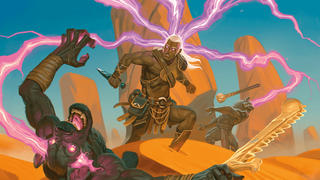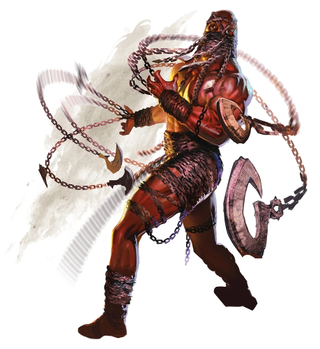The 5 most ridiculously broken builds in D&D history
From chicken summoners to psionic sandwiches.

In the era of D&D 3rd edition and its 3.5 update, character building was a wild west. The game's complex rules and deep customisation made it ripe for min-maxing—and an unbelievable barrage of first- and third-party expansion content meant there were always new races, classes, spells, and feats to mess around with, usually all hopelessly unbalanced against each other.
It was a time when every DM cringed at the sight of a player dropping a new book on the table, but at least for most the goal was just to put together a character optimal enough to breeze through that combat encounter that took four hours to prepare. A deviant few had darker designs in mind, and out in the dark corners of the Internet (and the WOTC official forums), they conspired to break not just the balance of the game, but the fundamental laws of its reality.
The darkest and most ludicrous of these forbidden builds passed into online legend—and though that's perhaps where they should've stayed, I've decided to dredge up a few of my favourites for you today. Call it a cautionary tale for the 5e players of today—what starts as some innocent experimentation with a Coffeelock build can soon take a turn.
Half-Ogre Spiked Chain Fighter

We'll start with a gentle one—a classic build strong enough to be game-ruining but not so contrived as to give your group a headache.
Creator: Various
The method
Pretty simple—just make a Fighter with the half-ogre racial template to make yourself Large, then take the Combat Expertise, Combat Reflexes, and Improved Trip feats. Oh, and get yourself a spiked chain—one of 3.5's most ridiculous weapon types.
The result
Large creatures can attack enemies up to 10 feet away; the spiked chain extends that reach to 20. Get someone to cast Enlarge Person on you, and that increases to 25. Here, 3.5's Attack of Opportunity rules kick in, and basically any time someone tries to move within a 20-25 foot circle of you, you get a free attack, which you use to trip them up. If you trip them, you get another free attack on them from Improved Trip. If they try to get up, or get away from you, you get another Attack of Opportunity. Any time they get remotely close, just move backwards a few feet. You're near-untouchable and make it a nightmare for any of your opponents to do anything.
The biggest gaming news, reviews and hardware deals
Keep up to date with the most important stories and the best deals, as picked by the PC Gamer team.
Does it actually work?
Pretty much, though you have to hope your DM never introduces a monster bigger than you or otherwise good at resisting your trip attempts. And, as immortalised in The Order of the Stick comic, make sure to look where you're going.
Pun-Pun the Kobold

Perhaps the most iconic overpowered build in D&D history, Pun-Pun elevates one of the lowliest creatures in the Monster Manual to godhood.
Creator: Khan the Destroyer
The method
The key to Pun-Pun is finding a way to transform into something called a "sarrukh"—the original build exploits an obscure racial template called Mulhorandi Divine Minion combined with a shapeshifting-focused prestige class called Master of Many Forms. Once you've gained the ability to turn into a Monstrous Humanoid of up to 14 hit dice, you're golden—doable within your first five levels, by this method, with a diversion into Wizard to get a viper familiar.
Sarrukhs have an ability called Manipulate Form, that lets them modify the stats of reptillian creatures (kobolds and vipers qualify, naturally). They can raise ability scores to match their own, and even grant spell-like abilities… including Manipulate Form itself. Pun-Pun turns into a sarrukh, uses Manipulate Form to give his familiar the Manipulate Form ability, turns back into a kobold, and then gets his familiar to use Manipulate Form to give Pun-Pun the Manipulate Form ability too.
The result
A few further steps are required, but the upshot is that Pun-Pun and his familiar are now free to endlessly raise each other's ability scores. They can also grant each other pretty much any special powers they want, thanks to the vague wording of Manipulate Form. Pretty soon Pun-Pun has over 20,000 Strength, Dexterity and Constitution, knows every spell and feat in the game, is immune to everything, and permanently invisible.
Does it actually work?
Legendary as it is, the Pun-Pun build has some major holes in it, not the least of which is the fact that in order to shapeshift into something, you have to know what it is—given the sarrukh are an extinct precursor race from tens of thousands of years in the past, that's not especially likely. Qualifying for the Master of Many Forms class in the first place also requires some very over-generous reading of the Divine Minion's rules, not to mention the question of how you even manage to become a holy avatar of the Mulhorand pantheon of gods in the first place.
Peasant Railgun

Maybe more of a concept than a build, though it'll kill a dragon in one round just the same.
Creator: Unknown
The method
Hire about 2,000 peasants and tell them to stand in a line. Get the one at the front to ready his action to make a throw attack, then get all the ones behind him to ready their actions to pass a rock down the chain. Then get the peasant right at the back to pick up a rock and pass it to the peasant in front of him.
The result
As the peasants pass the rock along the chain, the rock travels about two miles in one turn—which is six seconds real-time. That accelerates it to over 1000 miles an hour, over Mach 1, before the peasant at the front chucks it. How much damage does that do? That's up to the DM—but surely enough to punch through pretty much anything it hits. The Peasant Railgun can fire every two turns, or 12 seconds, making it pretty trivial to lay waste to entire fortifications. For more power, simply make the line of peasants longer.
Does it actually work?
This one's less a legitimate exploit and more a method of starting an argument with your DM. The key flaw in the Peasant Railgun is that it picks and chooses when to follow the rules of D&D, and when to instead follow the real-world laws of physics. If we follow D&D rules to the letter, then the rock gains no bonuses at all, because D&D doesn't have rules for acceleration like this. If we follow the laws of physics, then the peasants can't pass a rock at super-speed in the first place—and if they could, then the peasants in the latter half of the Railgun are getting their hands blown off before it can reach the end. Still, a good way to derail a quest you're not interested in with four hours of arguing about physics.
Psionic Sandwich

The beauty of this build is that it's perfectly optimised to do something completely pointless.
Creator: Tleilaxu_Ghola
The method
Get to level 20 as a Telepath. Make a sandwich. Polymorph the sandwich into a rabbit (or other small animal of your choice). Use the Astral Seed power to create a crystal that will store your mind and soul if you die. Commit suicide. From within the crystal, use the Mind Switch power to swap into the rabbit's body. Break the crystal. Use the Psychic Chirurgery power to restore the levels you lost by dying. Then, dispel all powers on yourself.
The result
You are now a level 20 sandwich. With the Subtle Spell feat, you can still use your psionic powers, enabling you to fly around and control people's minds quite happily, despite being made of bread and butter with ham in between.
Does it actually work?
There's an argument to be made that you shouldn't retain your mental ability scores as a sandwich, which would kill your career as a Telepath, though you would still have succeeded at turning yourself into a sandwich, which was of course the real goal here. Beyond that, it's a foolproof build.
Chicken-Infested Commoner

This build unleashes the potential of the game's weakest class. And its weakest farm animal.
Creator: Various
The method
There's a few different ways this build can go, but the first thing you need to do is take a level in Commoner—a feeble class usually intended only for NPCs to use. Use that to qualify for the Chicken-Infested feat, which was included as part of an April Fools feature on playing Commoners in Dragon magazine (the official D&D magazine). Thanks to this feat, every time you draw a weapon, you have a 50% chance of drawing a live chicken instead. Then buy yourself a spell component pouch.
The result
Drawing an item from a spell component pouch is a free action, and the pouch can contain as many components as you like. Combine it with Chicken-Infested, and you have the power to draw and drop as many chickens as you like in a turn. You are an infinite chicken machine.
There are a few different ways to take advantage of this. Using necromancy, you can rapidly slay and raise them from the dead for a zombie chicken army—even better if you take the Destructive Retribution feat to make them explode on death. If you prefer to get up close and personal, you can throw a chicken into combat, attack it, and use Cleave and Sweeping Strike to bounce a load of free attacks onto anyone standing near it.
But honestly, all that's just showing off. The truth is, there are few problems that can't be solved just with a thousand chickens appearing out of thin air. Trigger every trap safely by hurling chickens. Pour them into your enemy's fortress until there's no room left for anyone to move. Solve world hunger. The possibilities are endless.
Does it actually work?
Pretty much. You can definitely be challenged on the abuse of free actions (there's technically no limit on how many can be performed in a turn, but the rules do caution common sense on this point) but all that really does is slow down your chicken production. If your use of the spell component pouch is disputed, just take Quick Draw and as many clubs as you can carry instead (clubs are free, after all)—again, it's just reducing your rate of chickens-per-minute, not stopping you.
Sure, the feat does technically come from an April Fools joke, but at least it was a first-party April Fools joke, which makes it more legitimate than all the third-party nonsense everyone else's builds use.

Formerly the editor of PC Gamer magazine (and the dearly departed GamesMaster), Robin combines years of experience in games journalism with a lifelong love of PC gaming. First hypnotised by the light of the monitor as he muddled through Simon the Sorcerer on his uncle’s machine, he’s been a devotee ever since, devouring any RPG or strategy game to stumble into his path. Now he's channelling that devotion into filling this lovely website with features, news, reviews, and all of his hottest takes.
Most Popular


